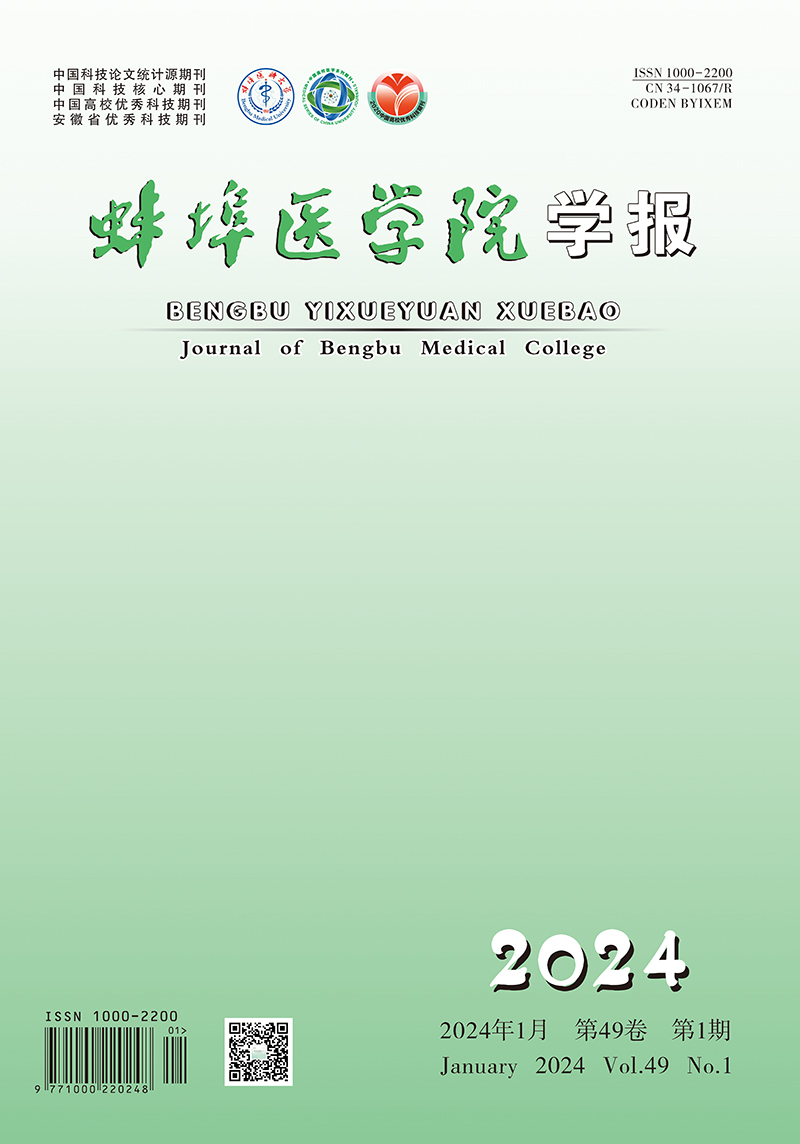-
肺癌是全世界癌症相关死亡的主要原因,每年约有200万新发病例和176万死亡病例[1]。其中小细胞肺癌(small cell lung cancer,SCLC)占肺癌总数的15%左右[2],以生长迅速、恶性程度高、易发生远处转移为特点,同时发病机制也更为复杂。其治疗尽管经过数十年的发展,仍获益有限,70%的病人确诊时均已处于广泛期,由于对化疗较为敏感,因此化疗是绝大多数SCLC病人的首选治疗方法。目前一线标准治疗方案是依托泊苷联合铂类(EP方案),但其预后不佳,5年生存率 < 3%,中位总生存期(OS) < 12个月[3]。
SCLC是神经内分泌肿瘤,通常由于抗利尿激素分泌异常,导致电解质异常,最常见的为低钠血症。已有研究[4-7]表明, 影响SCLC预后的因素包括性别、年龄、临床分期、淋巴结分期、胸腔积液、自身抗体和炎性细胞因子水平等。也有研究[8]认为低钠血症可能是SCLC远期预后不良的独立危险因素。但目前国内外关于低钠血症对SCLC病人近期疗效、不良反应及与预后的确切关系研究较少,并且尚存在一定争议。因此,本研究评估SCLC合并低钠血症病人经过2周期EP方案化疗后其近期疗效和不良反应,明确低钠血症能否作为SCLC病人预后不良的指标。
HTML
-
从我院病历管理系统中,调取呼吸与危重症医学科2018年7月至2022年2月收治的临床资料完整的首次确诊SCLC病人240例,按纳入标准和排除标准共纳入106例病人。
-
纳入标准:(1)所有病人均经纤维气管镜、支刷细胞学、胸水细胞学、超声或CT引导下经皮肺穿刺、EBUS-TBNA及内科胸腔镜等检查并经病理学、细胞学、免疫组织化学首次确诊为SCLC,且不可手术或拒绝手术者;(2)临床分期为广泛期病人;(3)体力状况评分(performance status,PS)为0~1分;(4)连续接受过2周期及以上EP方案化疗;(5)临床资料完整。排除标准:(1)临床资料缺失或不全的病人;(2)有长期胃肠功能障碍, 除肺癌原发疾病之外心、肝、肾引发的抗利尿激素水平紊乱的疾病;(3)合并有其他器官、系统恶性肿瘤;(4)PS评分为3~4分。
-
根据我院血清钠BECKMAN COULTER AU5800型全自动生化分析仪检测正常参考值范围137~147 mmol/L,将病人分为低钠血症组(< 137 mmol/L)38例和血钠正常组(≥137 mmol/L)68例。所有病人均采用EP方案化疗2周期后,评估其近期疗效和不良反应。
2周期化疗后根据血钠是否纠正,将低钠血症组分为血钠纠正组(≥137 mmol/L)及血钠未纠正组(< 137 mmol/L)2个亚组,进一步分析其与化疗疗效的关系。
治疗2周期后根据疗效将全部病例分为疾病控制组(CR+PR+SD)和疾病进展组(PD)。比较2组化疗前后胃泌素释放肽前体(ProGRP)和神经元特异烯醇化酶(NSE)水平。分析血清钠、ProGRP、NSE水平的相关性。
-
所有SCLC均采用EP方案化疗,依托泊苷100 mg/m2+0.9%氯化钠溶液500 mL,静脉滴注,d1~d3;顺铂80 mg/m2 +0.9%氯化钠溶液500 mL,静脉滴注,d1或卡铂AUC 6 +0.9%氯化钠溶液500 mL,静脉滴注,d1,每21 d为1个周期,共2个周期。
对于无临床症状的轻度低钠血症病人考虑可能是由于SCLC所致,无需治疗,对于中度以上低钠血症且症状明显者,如嗜睡、意识障碍、恶心呕吐、癫痫等,按补钠公式:(142-实测值)(mmol/L)×体质量(kg)×[0.6(男),0.5(女)]÷17 mmol+每天生理需要量,第一天给予一半或1/3,进行静脉补钠等治疗,必要时进行补钾治疗。
-
按实体瘤疗效判定标准RESIST 1.1评定,分为完全缓解(complete remission,CR)、部分缓解(partial remission,PR)、稳定(stable disease,SD)和进展(progressive disease,PD),比较客观缓解率(objective response rate,ORR)和疾病控制率(disease control rate,DCR)。ORR(%)=(CR例数+ PR例数)/总例数×100%;DCR(%)=(CR例数+ PR例数+ SD例数)/总例数×100%。病人治疗期间不良反应的评估依照美国国立癌症研究所制定的通用药物毒性反应判断标准(NCI CTCAE 3.0)进行分级:1级,轻度不良反应;2级,中度不良反应;3级,重度不良反应;4级,有生命危险或导致残废的不良反应;5级,可导致死亡的不良反应。
-
采用χ2检验、Fisher′s确切概率法、t检验、Pearson相关分析和秩和检验。
1.1. 一般资料
1.2. 纳入标准与排除标准
1.3. 分组
1.4. 化疗方案与低钠血症的治疗
1.5. 疗效评价
1.6. 统计学方法
-
本研究SCLC合并低钠血症的发生率为15.83%(38/240)。
-
2组病人临床分期、骨转移、胸腔积液、NSE水平、ProGRP水平差异均有统计学意义(P < 0.05);2组性别、年龄、是否吸烟、解剖学分型、远处转移脏器数、脑转移、肝转移差异均无统计学意义(P>0.05)(见表 1)。
临床特征 低钠血症组
(n=38)血钠正常组
(n=68)χ2 P 男
女30
857
110.39 >0.05 年龄/岁 >60
≤6024
1448
200.62 >0.05 是否吸烟 是
否23
1542
260.02 >0.05 临床分期 局限期
广泛期15
2341
274.24 < 0.05 解剖学分型 中央型
周围型29
959
91.89 >0.05 初诊远处转移脏器数 0 20 49 1~2 15 14 4.60 >0.05 ≥3 3 5 初诊脑转移 有
无10
2815
530.25 >0.05 初诊骨转移 有
无12
2610
584.22 < 0.05 初诊肝转移 有
无11
2717
510.20 >0.05 初诊胸腔积液 有
无14
2411
575.78 < 0.05 NSE/(ng/mL) 34.48±10.06 21.17±9.87 6.61△ < 0.05 ProGRP/(pg/mL) 1 775.40±655.86 1 144.43±631.48 4.87△ < 0.05 △示t值 -
低钠血症组病人ORR、DCR均低于血钠正常组(P < 0.05)(见表 2)。
分组 n CR PR SD PD ORR DCR 低钠血症组 38 1(2.63) 17(44.74) 13(34.21) 7(18.42) 18(47.37) 31(81.58) 血钠正常组 68 3(4.41) 43(63.24) 19(27.94) 3(4.41) 46(67.65) 65(95.59) χ2 — 2.32△ 4.19 4.08* P — < 0.05 < 0.05 < 0.05 △示uc值;*示校正χ2值 -
2组病人在白细胞减少、中性粒细胞减少、血小板减少、血红蛋白减少、肝功能损害、肾功能损害方面差异均无统计学意义(P>0.05);与血钠正常组比较,低钠血症组病人更容易出现胃肠道反应(P < 0.05)(见表 3)。
分组 n 白细胞减少 中性粒细胞减少 血小板减少 0 Ⅰ~Ⅱ Ⅲ~Ⅳ 0 Ⅰ~Ⅱ Ⅲ~Ⅳ 0 Ⅰ~Ⅱ Ⅲ~Ⅳ 低钠血症组 38 27 9 2 24 11 3 30 7 1 血钠正常组 68 53 12 3 53 10 5 58 9 1 χ2 — 0.63 2.68 0.70 P — >0.05 >0.05 >0.05 分组 n 血红蛋白减少 胃肠道反应 肝功能损害 肾功能损害 0 Ⅰ~Ⅱ Ⅲ~Ⅳ Ⅰ~Ⅱ Ⅲ~Ⅳ Ⅰ~Ⅱ Ⅲ~Ⅳ Ⅰ~Ⅱ Ⅲ~Ⅳ 低钠血症组 38 22 15 1 22 8 4 1 5 0 血钠正常组 68 47 20 1 29 9 6 1 6 0 χ2 — 1.35 5.64 0.02* 0.14* P — >0.05 < 0.05 >0.05 >0.05 *示校正χ2值 -
低钠血症组经两周期化疗后血钠纠正22例,血钠未纠正16例。血钠纠正组病人ORR和DCR均高于血钠未纠正组(P < 0.05)(见表 4)。
分组 n CR PR SD PD ORR DCR 血钠纠正组 22 1(4.55) 13(59.09) 7(31.82) 1(4.55) 14(63.64) 21(95.45) 血钠未纠正组 16 0(0.00) 4(25.00) 6(37.50) 6(37.50) 4(25.00) 10(62.50) P — — — — — < 0.05△ < 0.05△ △示Fisher′s确切概率值 -
106例SCLC病人治疗2周期后,疗效评价为CR 4例,PR 60例,SD 32例,PD 10例,其中疾病控制组(CR+PR+SD)96例,疾病进展组(PD)10例。化疗前,2组NSE水平差异无统计学意义(P>0.05),疾病进展组的ProGRP水平高于疾病控制组(P < 0.05);疾病进展组化疗前后ProGRP、NSE水平差异均无统计学意义(P>0.05),疾病控制组化疗后ProGRP、NSE水平均低于化疗前(P < 0.05);化疗后,2组NSE水平差异无统计学意义(P>0.05),疾病进展组的ProGRP水平明显高于疾病控制组(P < 0.01)(见表 5)。
分组 n NSE/(ng/mL) ProGRP/(pg/mL) 化疗前 疾病控制组 96 25.71±12.20 1 321.99±705.39 疾病进展组 10 28.15±6.53 1 837.63±543.65 t — 0.62 2.24 P — >0.05 < 0.05 化疗后 疾病控制组 96 16.79±7.68* 262.77±129.19* 疾病进展组 10 20.13±7.07 1 645.27±671.22 t — 1.32 17.87 P — >0.05 < 0.01 组内比较*P < 0.05 -
SCLC病人中血清钠水平与NSE、ProGRP水平均呈负相关关系(r=-0.588、-0.642,P < 0.05)。
2.1. SCLC合并低钠血症的发生率
2.2. 低钠血症组与血钠正常组SCLC病人一般资料比较
2.3. 低钠血症组与血钠正常组SCLC病人近期疗效比较
2.4. 低钠血症组与血钠正常组SCLC病人不良反应比较
2.5. 血钠纠正组与血钠未纠正组近期疗效比较
2.6. 疾病控制组与疾病进展组NSE、ProGRP水平比较
2.7. SCLC病人血清钠水平与NSE水平、ProGRP水平相关性分析
-
肺癌是世界范围内死亡率最高的恶性肿瘤[9]。其中SCLC约占肺癌的15%,SCLC中15%~30%合并低钠血症[10],本研究结果显示,SCLC合并低钠血症的发生率15.83%,与上述研究结果相似。其原因多是由于原发或继发分泌异常抗利尿激素所致,即抗利尿激素分泌异常综合征[11-12],其主要临床症状为顽固性稀释性低钠血症[13]。SCLC病人合成和分泌抗利尿激素过多,刺激肾脏集合管的V2受体导致水潴留、尿钠增多以及稀释性低钠血症,从而使血渗透压下降引起一系列临床症状。轻者可无明显临床症状,或仅表现为注意力不集中、头晕、乏力,中度则出现恶心、呕吐,重度可能出现精神神经系统改变如神志淡漠、腱反射减弱,极重度者甚至会出现呼吸困难、昏迷以及低血容量性休克。另有研究[8]报道低钠血症还可能降低肿瘤病人对放化疗反应,缩短总生存期。
本研究结果显示,低钠血症组与血钠正常组SCLC病人在临床分期、骨转移、胸腔积液、NSE水平、ProGRP水平方面差异均具有统计学意义;而在性别、年龄、是否吸烟、解剖学分型、远处转移脏器数、脑转移、肝转移方面差异均无统计学意义,这与已有的研究[14-15]结果一致。经过两周期EP方案化疗后评价,低钠血症组ORR和DCR明显低于血钠正常组的ORR和DCR,这与刘诗昂[14]研究结果相似。荆扬飞等[15]通过对SCLC病人低钠血症各严重程度组(正常、轻、中、重4个亚组)临床指标进行分析,发现正常、轻、中、重度低钠组之间NSE、ProGRP、中性粒细胞百分比(NEUT%)、血红蛋白(Hb)、乳酸脱氢酶、肌酐(Cr)、尿酸(UA)、有无胸腔积液差异均有统计学意义,并且一线化疗后,钠纠正组与钠未纠正组病人在NEUT%、Cr、UA,差异也具有统计学意义。本研究中,2组病人在白细胞减少、中性粒细胞减少、血小板减少、血红蛋白减少、肝功能损害、肾功能损害方面差异均无统计学意义;但在胃肠道反应(恶心、呕吐)方面低钠血症组较血钠正常组更容易出现,且低钠血症组出现Ⅲ~Ⅳ胃肠道反应较多。究其原因可能是由于SCLC本身合并低钠血症,恶心、呕吐又是化疗最常见的不良反应之一,严重的恶心、呕吐可导致胃液、肠液大量丢失从而加重低钠血症。国家综合癌症网络的止吐指南表明,低钠血症是化疗引起的恶心呕吐(CINV)的一个危险因素,尽管CINV的发病率与低钠血症之间的关系尚未被充分研究。日本的一项前瞻性观察性研究[16]结果提示,低血钠浓度可能增加CINV的发病风险。本研究化疗两周期后再将低钠血症组根据血钠是否纠正分为血钠纠正组与血钠未纠正组进行分析,血钠纠正组的ORR和DCR高于血钠未纠正组的ORR和DCR。YANG等[17]研究也表明纠正低钠血症组的预后明显优于未纠正组。FIORDOLIVA等[8]研究发现通过对病人限制液体摄入、等渗盐水、高渗盐水(3%氯化钠溶液)、盐片、去甲丙咪嗪、锂盐、袢利尿剂、尿素片、托伐普坦及针对各临床指标的异常进行对症处理,在恢复血清钠值同时再化疗可以改善预后。因此,血钠是否纠正也是SCLC预后的一个相关因素。总之,合并低钠血症的SCLC病人化疗疗效差,因此纠正血清钠值应该能够改善化疗疗效,从而延长病人的生存期,改善病人生存质量。
ProGRP是GRP的前体结构,普遍存在于非胃窦组织、神经纤维、脑和肺的神经内分泌细胞中。NSE是神经元和神经内分泌细胞所特有的一种酸性蛋白酶。在来源于神经外胚层或神经内分泌组织的肿瘤病人血清中可以检测到高水平的NSE,如神经母细胞瘤和SCLC。ProGRP、NSE被认为是SCLC的敏感肿瘤标志物。SUH等[18]研究表明,NSE增高是一线化疗CR或PR病人复发的预测因素。KORSE等[19]研究也证实ProGRP是影响SCLC病人疗效、总生存期和无进展生存期的因素。本研究对纳入的106例SCLC病人检测2周期化疗前后血清ProGRP和NSE的表达水平,结果显示,疾病控制组ProGRP、NSE水平低于化疗前水平;而疾病进展组ProGRP、NSE水平与化疗前差异无统计学意义。因此,ProGRP和NSE水平可作为SCLC疗效评估的预测因子。另有多项研究[20-22, 17]认为NSE、ProGRP、NEUT%、Hb、Cr、UA、碱性磷酸酶、L-γ谷氨酰转肽酶、天门冬氨酸转移酶、有无胸腔积液等指标均与SCLC病人预后相关。有研究[8]也表明低钠血症是SCLC病人预后不良的独立危险因素。本研究结果显示,SCLC病人中血清钠水平与NSE、ProGRP水平均呈负相关关系。因此,在临床治疗SCLC时一定要注意是否合并低钠血症,并及时纠正,以提高SCLC病人化疗疗效,从而改善预后。
综上所述,SCLC合并低钠血症病人临床分期更晚,更易出现骨转移、胸腔积液,对化疗反应差,更容易出现胃肠道不良反应,纠正血钠水平能改善病人预后,且血清钠水平与ProGRP、NSE水平均呈负相关关系。因此,低钠血症可以作为SCLC病人预后判断的一项指标,纠正低钠血症可改善病人预后。而关于SCLC合并低钠血症仍有许多问题有待进一步研究,如低钠血症的程度与肿瘤进展、复发速度是否存在相关性, 我们将进一步扩大样本量进行前瞻性研究。






 DownLoad:
DownLoad: